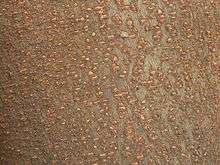Warburgia salutaris
| Warburgia salutaris | |
|---|---|
 | |
 | |
| Scientific classification | |
| Kingdom: | Plantae |
| (unranked): | Angiosperms |
| (unranked): | Magnoliids |
| Order: | Canellales |
| Family: | Canellaceae |
| Genus: | Warburgia |
| Species: | W. salutaris |
| Binomial name | |
| Warburgia salutaris (Bertol.f.) Chiov. | |
Warburgia salutaris (pepper-bark tree, Afrikaans: Peperbasboom, Sotho: Molaka, Venda: Mulanga, Zulu: Isibaha)[1] is a species of tree in the Canellaceae family. It is found in Botswana, Namibia, Tanzania, Zambia, Mozambique, South Africa, Swaziland, Malawi and Zimbabwe. It is threatened by habitat loss. It is a popular medicinal plant and is overharvested in the wild, another reason for its endangerment.[2] The Pepper-bark tree is a protected tree in South Africa.[1] Various projects are investigating methods of propagation under controlled conditions with subsequent planting in the wild.[3]
This is an erect tree growing up to about ten metres in maximum height, but known to reach 20 metres at times. It has a thick canopy of aromatic, shiny green leaves. The evergreen leaf blades are lance-shaped, measuring up to 11 cm long by 3 wide. The flowers have ten yellow-green petals. They are each just under a centimeter long and are solitary or borne in small clusters of up to 3. The fruit is a berry, leathery purple or black in color when ripe, measuring up to 4 cm wide.
The leaves are used to add peppery flavoring to food and tea.[3] The bitter taste of the tree's bark and leaves is due to the presence of iridoids.[4] The herbage and fruit are fed to animals.[3] The aromatic, oily, yellowish wood is used for firewood.[3]
This plant is used medicinally by the Maasai people to treat malaria.[5] It is used as a snuff or smoked for respiratory complaints such as common cold and cough.[3] The bark can be purchased at markets in Tanzania,[6] and elsewhere.[7] A chemical compound isolated from the bark of the tree shows antimicrobial activity at high concentrations.[4]
It is attractive and makes a good shade tree.[3]
References
- 1 2 "Protected Trees" (PDF). Department of Water Affairs and Forestry, Republic of South Africa. 3 May 2013.
- ↑ PlantzAfrica
- 1 2 3 4 5 6 W. salutaris. World Agroforestry.
- 1 2 Mohanlall, V. and B. Odhav. (2009). Furans and furanones with antimycotoxigenic activity isolated from Warburgia salutaris (Canellaceae). Journal of Medicinal Plants Research 3:4 231-40.
- ↑ Bussmann, RW; Gilbreath, GG; Solio, J; Lutura, M; Lutuluo, R; Kunguru, K; Wood, N; Mathenge, SG (2006). "Plant use of the Maasai of Sekenani Valley, Maasai Mara, Kenya". Journal of ethnobiology and ethnomedicine. 2: 22. doi:10.1186/1746-4269-2-22. PMC 1475560
 . PMID 16674830.
. PMID 16674830. - ↑ Indigenous multipurpose trees of Tanzania.
- ↑ Botha, J.; Witkowski, E.T.F.; Shackleton, C.M. (2004). "The impact of commercial harvesting on Warburgia salutaris ('pepper-bark tree') in Mpumalanga, South Africa". Biodiversity and Conservation. 13 (9): 1675. doi:10.1023/B:BIOC.0000029333.72945.b0..
External links
- Hilton-Taylor, C., Scott-Shaw, R., Burrows, J. & Hahn, N. 1998. Warburgia salutaris. The IUCN Red List of Threatened Species 1998. Downloaded on 08 October 2015.
